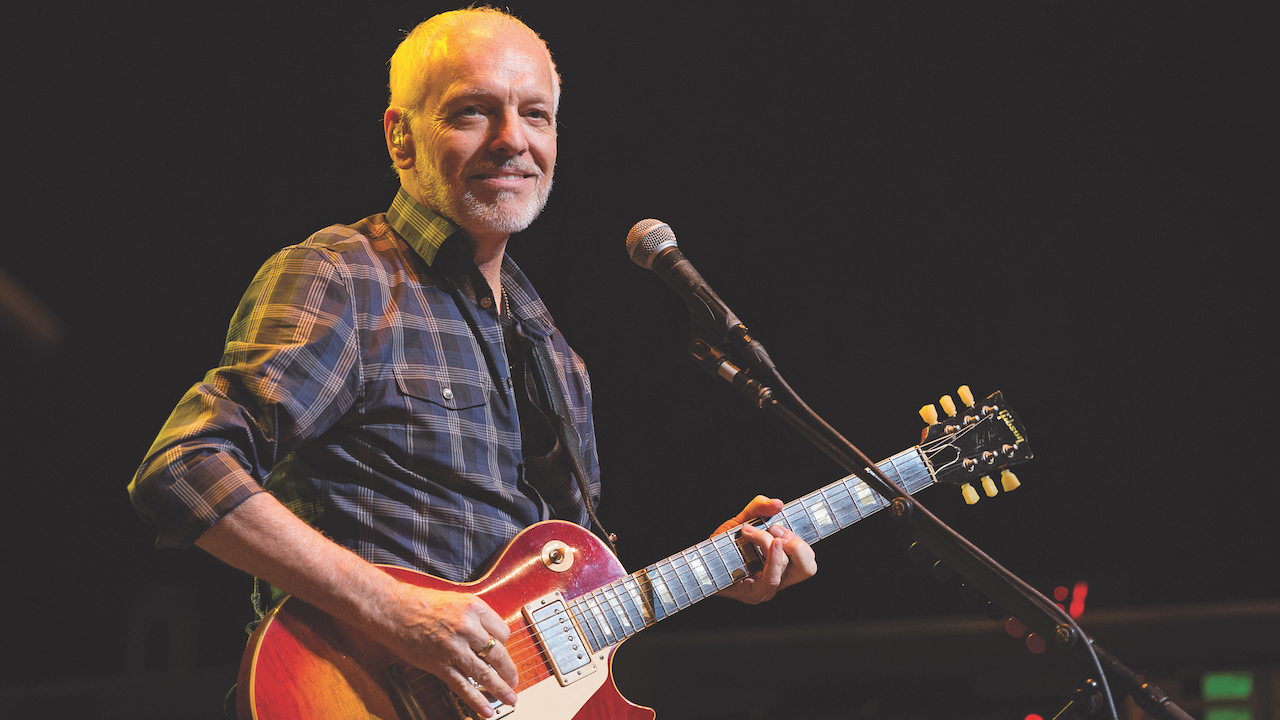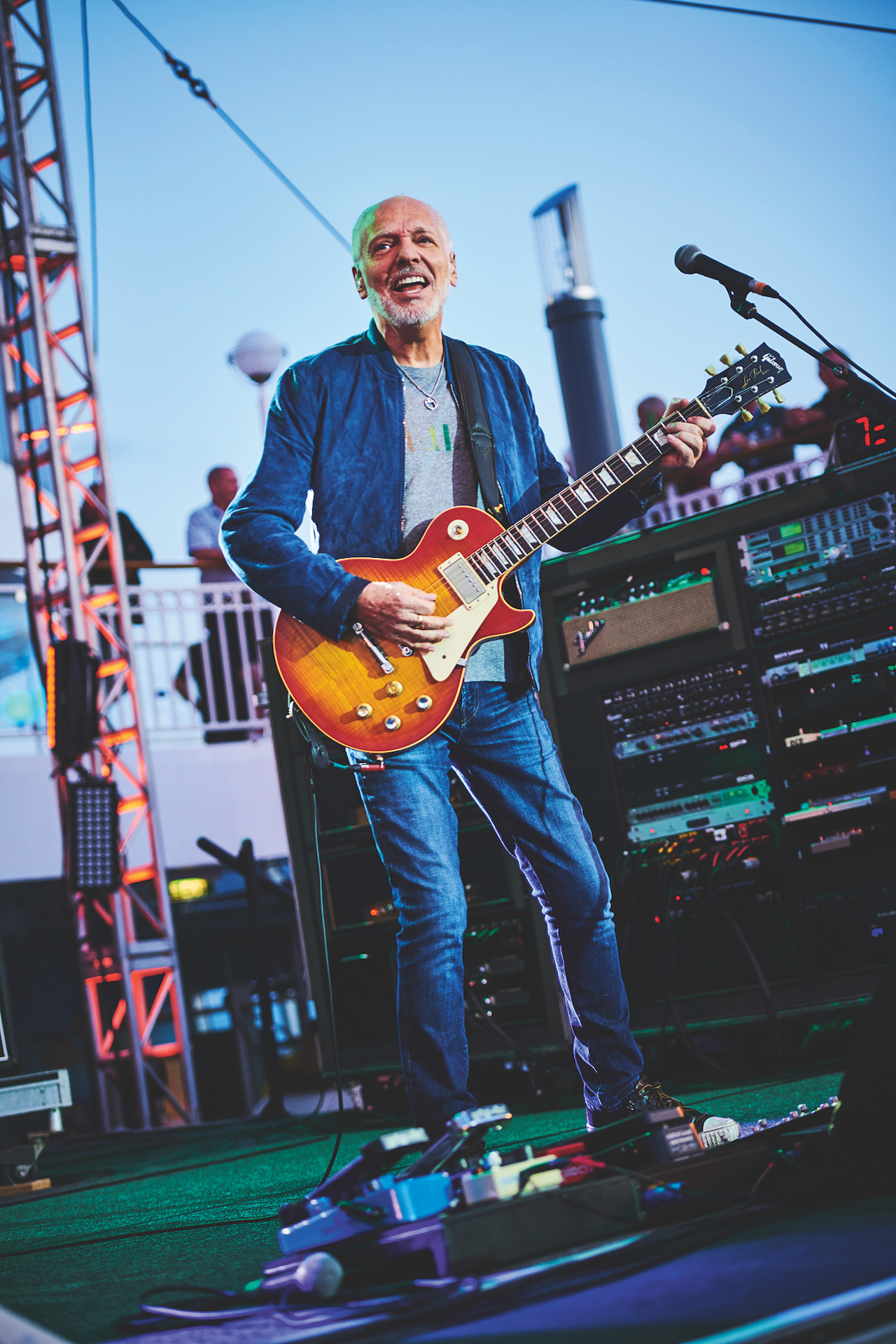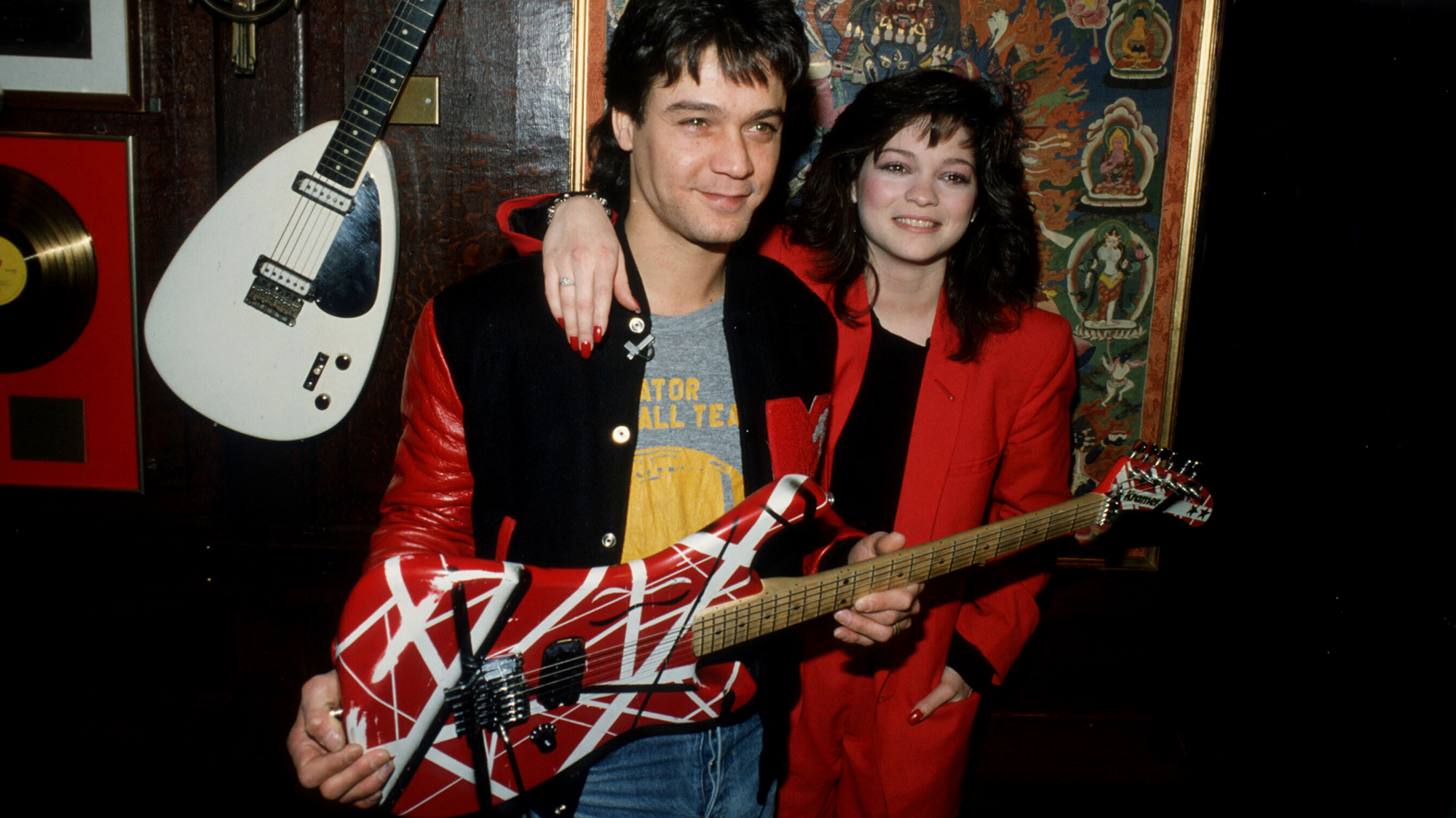“If we were recording at Olympic Studios, we would often hear Led Zeppelin. I’d see Jimmy Page sitting there, overdubbing in darkness”: Peter Frampton reveals the stories behind five of his classic tracks

When Peter Frampton co-founded Humble Pie in 1969, he was already regarded as one of England’s hottest guitarists, but his songwriting skills hadn’t yet blossomed. He contributed a number of strong cuts to the four studio albums he recorded with the band during his brief, two-year tenure, but it wasn’t until he turned solo and began issuing his own albums, starting with 1972’s Winds of Change, that his compositional chops began to equal his skills as an instrumentalist.
“I can’t say I always enjoy the process of writing,” he says. “I do like coming up with bits – a riff or a chord pattern. Sometimes a title comes to me that sparks something. But putting a song together and actually finishing it can be quite painful, especially when it comes to writing lyrics. That can take a while. It isn’t until I’ve got the whole thing down and I’ve got a little demo version of a song that I can feel enjoyment.”
In 1976, Frampton released his monster-selling concert recording, Frampton Comes Alive!. The album was something of an unofficial greatest-hits collection, containing the tastiest gems from his previous solo albums, among them Show Me the Way, Baby, I Love Your Way, Lines on My Face, and Do You Feel Like We Do.
Although the two-disc set spent 10 weeks atop the U.S. Billboard 200 albums chart, none of its singles hit number one. At the height of his fame in 1977, Frampton came close to that mark when the title track from his studio album I’m in You reached number two on Billboard’s Hot 100.
“Everybody thought I’m in You would hit number one because the live album was enormous,” the guitarist tells Guitar Player. “It was the lead single from I’m in You, which certainly isn’t my favorite album or anywhere near my best, but it’s a great song and I thought it deserved to be a hit.

“The truth is,” he continues, “I never thought about chart positions and things like that. After I left Humble Pie in 1971, I didn’t give any thought to having hits. That just wasn’t what I concentrated on. I was more concerned with being inspired, and writing good songs and making sure they were recorded right. My attitude was, ‘Do I like the song?’ It always came down to that.”
After announcing that he was suffering from a progressive muscle disorder called IBM (inclusion body myositis), Frampton embarked on a 2019 “farewell tour,” which fortunately didn’t live up to its billing. Last year, he came out of retirement and hit the road on his Never Say Never tour, which he’s extended into this year.
Meanwhile, he’s combing through demos and planning a studio album of all-new material, but as he jokes, “I’ll probably be 86 by the time it comes out, because I’m such a perfectionist.”
Here, he shares the stories behind five key tracks from his storied career.
1. Stone Cold Fever – Humble Pie (Rock On, 1971)
“I came up with the opening riff the night before a rehearsal. I played around with it on an acoustic – it sounded kind of Zeppelin-esque. We were all influenced by them. In fact, if we were recording at Olympic Studios, we would often hear Zeppelin. To get to the mix room, we’d have to walk through the control room of Studio A. I’d see Jimmy Page sitting there, overdubbing in darkness.
“Anyway, I recorded the riff on a Sony recorder and I brought it in to play for the guys. We were rehearsing at this place in the country – Magdalene Laver Village Hall. The second Steve Marriott heard the riff, he jumped on it right away. He loved it.
“We started arranging the song pretty quickly. I remember we would go into the kitchen to have a cup of tea or light up a joint – ’course, I wasn’t smoking then. Quite often we’d all come up with our words for verses, but for this song Steve wrote the whole thing. He did all the vocals.
“We had the song down before we started recording. It was a very special session for me, actually, because I played a very long solo at the end – it goes into a jazzy, almost freeform kind of thing. I tracked it live with the band, and then we went in the control room to listen back. I didn’t say anything to the band, but as I heard my solo I got this feeling in my stomach, and I thought, ‘I don’t think I’m copying anybody else anymore. I really believe this is me for the first time.’”
2. Lines On My Face – Peter Frampton (Frampton's Camel, 1973)
“My marriage was breaking up. It was a very sad time, and basically the whole Frampton’s Camel record is about lost love and wanting someone back who doesn’t want you.
“I wrote the music to Lines on My Face in Manhattan. I was staying at my manager’s place on Park Avenue. I had a Martin D-45 that I bought at Manny’s, and with that I wrote the music and melodies. But I needed a quiet place to write the lyrics, so a good friend of mine, Frank Carillo, a wonderful guitar player and singer, said I could stay at his place on Long Island. Frank’s mom kicked his brother out of his room so I didn’t have to sleep on the couch. I sat on the bed and wrote the lyrics.
“Before we started recording, my drummer exploded, as usual, so [engineer/co-producer] Eddie Kramer gave me names of the best session guys in New York City. The only one who answered his phone was John Siomos, who turned out to be one of the best and most unique drummers I’ve worked with. Lines on My Face was the first song we did. It was me, Frank Carillo, Rick Wills on bass, Mick Gallagher on keys, and John on drums. Frank played a D-35 and I had my D-45.
“For the electric parts, I used my ’54 Les Paul – the one everybody knows as the Phenix. I remember we spent a whole day getting sounds, and Eddie Kramer was getting ready to leave. I told him I wanted to cut the solo, and he said we only had 25 minutes left. I said, ‘It won’t take long,’ even though I didn’t have anything worked out, which I never do. I never work out my solos in advance. What you hear on the record is one take.”
3. Show Me The Way – Peter Frampton (Frampton, 1975)
“I had three weeks to write before we started the album, so I took my Les Paul and an Epiphone acoustic and I went to the Bahamas, where I stayed at Steve Marriott’s cottage on the beach. I ran into Alvin Lee and his wife, and we spent two weeks hanging out and having way too much fun. Thank God I had eight days left after they left. On my first day to myself, I picked up the Epiphone, tuned it to open G, and within 20 minutes I had most of the music and melodies to Show Me the Way.
“I put the guitar down and said, ‘I’ve got to write.’ I started singing ‘show me the way.’ The words just came out – I was in the moment. As I’m doing this, I’m thinking, ‘What am I trying to say?’ But the words came easily and they fit, so I kept going. I put down what I had on my Sony CF-550A [boom box]. It felt pretty good.
Show Me the Way got tons of play on KSAN in San Francisco... That’s why we recorded the live album at Winterland. San Francisco was our town
“The band recording went smoothly. We did it as a three-piece: me, John and my old cohort from the Herd – Andrew Brown, on bass. This is the first time I used a talk box in the studio. I had been using one live since ’73, but I never recorded with it. Nobody was around except Chris Kimsey, the engineer, so we experimented with it and we loved it. It’s a very clean talk-box sound compared to the way it sounds on the live record. On Frampton Comes Alive!, we were a four-piece, so everything sounded bigger.
“Show Me the Way got tons of play on KSAN in San Francisco. That station jumped on the Frampton album – it was Frampton all the time. That’s why we recorded the live album at Winterland. San Francisco was our town. They were way ahead of Detroit and New York.”
4. Breaking All The Rules – Peter Frampton (Breaking All The Rules, 1981)
“I was going through old tapes of jams because I wanted to do a real rock and roll–type track. I found this jam of me and John Siomos and thought it sounded great. It was like we were doing the Stones. As I listened, I thought, ‘No, it’s more than that.’ John was just kicking ass. The riff was pretty powerful, so I finished up the music, and there it was.
“I was working with David Kershenbaum as my co-producer, and we talked about making a very live-sounding rock record. We recorded at a sound stage on the A&M lot. It was a blast cutting tracks. I had John Regan on bass, Arthur Stead on keys, and I had half of Toto: Steve Lukather on guitar and Jeff Porcaro on bass. We played like a real live band, and every time we did the song it kept getting better and better. Playing with Luke was scary. [laughs] He’s such a lovely, crazy man.
“I had lost my Les Paul by this time, so I used one of the very first Roland synth guitars. Actually, Luke had one too, so he showed me what it could do and what you could do with it. I didn’t demo the solo, as usual. It was all cut live, very spontaneous.
“It’s a pretty vicious song, and we felt like we needed strong lyrics, so I sent a cassette to Keith Reid. He was such a brilliant lyricist. We spoke on the phone and I told him what I was looking for, and he sent me back more than enough lyrics for a song – it was like a book. David Kershenbaum and I went through it and picked out all the lines that fit best. It was great. To think Keith and I did it all by mail. We didn’t have Zoom then!”
5. Dreamland – Peter Frampton (Frampton Forgets The Words, 2021)
“I watched a documentary on Jaco Pastorius and I couldn’t believe that I hadn’t done a ‘thesis’ on him before; that’s what I call it when I go deep into somebody’s playing. I started to listen to everything he did, and I became so enamored of him. Sure, he could play fast, but his sense of melody was something else.
“I called my keyboard player and band leader, Rob Arthur, and I said we had to do Jaco’s Dreamland. We got together and put down a click while I played Jaco’s parts on guitar. I inhabited the melody, which I love to do. I didn’t even have to think about it. After we finished it, we did the blues album [2019’s All Blues], so once that was done I told Rob that we needed to revisit Dreamland.
“We put the band on the track, but I didn’t change anything about my guitar. What you hear on the record is what I did on day one. I used my ’60 ’Burst on the neck pickup.
“I’ve spoken to Jaco’s son and brother, so I feel like I know the family a bit now. When I finished the album, I sent it to Andrew Brown. He’s been my buddy since I was 16, and he’s played in my band. After he listened to the album, he emailed me and wrote one word: Dreamland. It meant a lot to me that someone I respect so much would pick that one song.”
- For live dates and goings-on in Frampton's world, visit the guitarist's website.
Get The Pick Newsletter
All the latest guitar news, interviews, lessons, reviews, deals and more, direct to your inbox!

Joe is a freelance journalist who has, over the past few decades, interviewed hundreds of guitarists for Guitar World, Guitar Player, MusicRadar and Classic Rock. He is also a former editor of Guitar World, contributing writer for Guitar Aficionado and VP of A&R for Island Records. He’s an enthusiastic guitarist, but he’s nowhere near the likes of the people he interviews. Surprisingly, his skills are more suited to the drums. If you need a drummer for your Beatles tribute band, look him up.
"This 'Bohemian Rhapsody' will be hard to beat in the years to come! I'm awestruck.” Brian May makes a surprise appearance at Coachella to perform Queen's hit with Benson Boone
“We’re Liverpool boys, and they say Liverpool is the capital of Ireland.” Paul McCartney explains how the Beatles introduced harmonized guitar leads to rock and roll with one remarkable song















